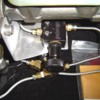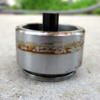When I got my car 20 yrs ago the PO had installed a second stock caliper on each rear wheel. I suspect as a result the car has always had more brake pad drag, evidenced by resistance to rotating the wheel by hand or pushing the car. (The rotors are not warped-- the resistance is steady.)
I believe the cars came with a brake proportioning valve, which was removed when the aftermarket (GM I think) master cylinder was installed. (Again, by the PO). My understanding is that said proportioning valves are to prevent rear wheel lockup.
I would like to remove the redundant rear calipers to eliminate the extra drag, and my question is whether I have to reinstall a proportioning valve if I do that.
I am running 285/40-17 and front 215/45-17 front tires, Goodyear Eagle F1. Looking at that puny rear pad I find it hard to believe that it will lock up that wide tire before the larger front pads will lock up the much narrower front tire.
So I'm thinking removing the extra rear caliper will not require a proportioning valve. Does that sound logical?
I'll disassemble the calipers also to check their condition after 20 yrs of silicone fluid use.
Original Post



